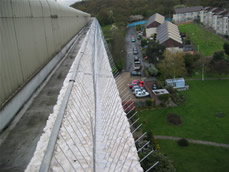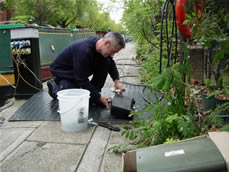Carpet Beetle
Pest Name: Carpet Beetle - Anthrenus Verbasci
Markings: Thorax / elytra have white/beige/brown/black mottled markings to give a 'camouflage' appearance. Larval stages are small and hairy.
Location: Window ledges, under legs of furniture, roof spaces (bird's nests), carpets, clothes, furs and stuffed animals.
Detection: Visual sightings of adults or larvae. Chewed fibres and fabrics, often around fixtures and fittings. Cast larval skins.
After the adult female has laid her eggs in the home she may be noticed on window boards attracted by the natural light, wanting to return to the plants and flowers outside which are her food source.
The larvae will be deep into their feeding material and are not sighted until very noticeable damage occurs to household furnishings. Cast larval skins may be evident, but will need in-depth inspection, as they are small and are usually in cracks and crevices. When checking for carpet beetle activity, it is important to lift and move as many of the items of furniture, furnishings and fabrics as possible, otherwise potential harbourages may be missed, and the infestation will quickly re-establish.
General Information: Size - 2 - 4 mm overall body length.
Carpet beetles are found widely throughout Europe. There are several species of carpet beetle, including the two-spot carpet beetle (Attagenus Pellio), the furniture carpet beetle (Anthrenus flaviceps) and the varied carpet beetle (Anthrenus verbasci).
The varied carpet beetle is the most commonly found infesting homes, and flies readily from site to site. The adult beetle is about 3 mm in length and is dark brown, mottled with white or yellowish patches.
The adult beetles live on plants, feeding on pollen and nectar of e.g. Hogweed or Spirea. They enjoy bright warm conditions and cause no noticeable damage. The larvae (Woolly Bears) feed on natural materials of animal origin such as bird nests and woollen carpets. During the long larval stage damage to clothing and furnishings made of natural fibres may be noticed. All natural fibres in the building should be examined to establish the extent of the infestation.
Biology: Adult beetles live out of doors, but females fly to lay between 50 and 100 eggs indoors on food material. These eggs hatch into the larval stage commonly known as the 'Woolly Bear'. The larvae are about 5 mm in length and covered in tufts of arrow headed bristles that give rise to the common name.
During this larval stage the larva has between five and twenty skin moults. The larvae can remain at the larval stage for over 100 days depending on food supply and temperature. Pupation into the adult from occurs during the last of these skin changes.
Wasps & Hornets have a potentially fatal sting
We Promise:
-
Fast Call Out Times
-
Competitive Prices
-
Smart Solutions
-
Friendly Help & Advice
-
Preventative Measures
For a fast competitive and professional solution
Call us: 01634 402599



